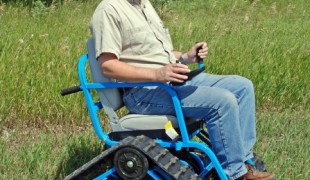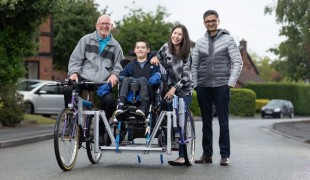- 3888
- 329
- 8
- 9
- 0
- Help Ukraine
About the solution
Rosana has no engineering, medical or technical degree. She is a self-taught who searched on her own to help her mother. It took the inventor 25 years to fully develop her product. The device consists of a vertical metal structure, with an electric motor, and wheels, that allows the user to keep standing up.
Rose had a car accident, in 1991, which left her paralyzed and almost got her killed. Her daughter didn’t want to accept that she would never be able to stand, so she developed the Up Rose.
“The doctors told me my mother would never walk again. I started dreaming that, one day, I would be able to see my mother standing up again, doing simple daily activities”, the inventor explained.
This dream came true, because Rosana worked hard to invent a creative and innovative solution, inspired by a childhood memory. “My father used to fill an oil drum with water, so I would use it in the summer as a small pool. At some point, the water would stop my body from going down. So I tried to adapt that idea into this device”, Rosana described.
“Now I can hug my children and my grandchildren. I wasn’t able to do that when I’m on the wheelchair”, Rose said.
The invention did safety tests in Universidade Federal de Minas Gerais.
Rosana is already sharing her solution: She gave an Up Rose to Davi Abreu, a Paralympic rugby player.
Adapted from: http://glo.bo/1paE7PL
More info: http://www.uprose.com.br/historia
What about you, do you have any solutions? Please share them with the Patient Innovation community!
这些解决方案不应包括使用药物,化学品或生物制品(包括食品);创伤性设备;冒犯性的,商业或内在危险的内容。该解决方案未经医学验证。请谨慎进行!如果您有任何疑问,请咨询健康专家。
DISCLAIMER: This story was written by someone who is not the author of the solution, therefore please be advised that, although it was written with the utmost respect for the innovation and the innovator, there can be some incorrect statements. If you find any errors please contact the patient Innovation team via info@patient-innovation.com
-
-
423
-
0
-
6347

Parents create a track-chair for their paralysed son
MOVING IN A WHEELCHAIR: Moving using a wheelchair.
CAREGIVING
Paralysis
Neuromuscular Disorders
Walking Aid (wheelchair/walker/crutches)
Assistive Daily Life Device (to help ADL)
Gait abnormalities (e.g., walking difficulties, unsteady gait)
Difficulty coordinating movements
Stiffness or rigidity (difficulty moving)
Paralysis of the legs and lower body
Muscle weakness
Loss of balance
Promoting inclusivity and social integration
Maintaining Balance and Mobility
Preventing (Vaccination, Protection, Falls, Research/Mapping)
Caregiving Support
Neurology
Neurosurgery
Orthopedics
Rheumatology
United States
-
-
-
368
-
0
-
5400

Students create a wheelchair to ease travellers' experience
MOVING IN A WHEELCHAIR: Moving using a wheelchair.
CAREGIVING
Traveling
Neuromuscular Disorders
Walking Aid (wheelchair/walker/crutches)
Gait abnormalities (e.g., walking difficulties, unsteady gait)
Stiffness or rigidity (difficulty moving)
Paralysis of the legs and lower body
Maintaining Balance and Mobility
Caregiving Support
General and Family Medicine
Neurology
Orthopedics
Rheumatology
United Arab Emirates
-
-
-
376
-
0
-
4393

Man builds special bicycle for boy in a wheelchair
MOVING IN A WHEELCHAIR: Moving using a wheelchair.
CAREGIVING
Hereditary Muscle Disorders
Neuromuscular Disorders
Walking Aid (wheelchair/walker/crutches)
Difficulty walking or moving
Muscle weakness
Muscle cramps or spasms
Difficulty coordinating movements
Stiffness or rigidity (difficulty moving)
Paralysis of the legs and lower body
Limited range of motion
Muscle pain or stiffness
Loss of balance
Reduced grip force (grip)
Cognitive impairment
Joint deformity
Difficulty getting up from the floor
Maintaining Balance and Mobility
Preventing (Vaccination, Protection, Falls, Research/Mapping)
Caregiving Support
Medical Genetics
Neurology
Orthopedics
Pediatrics
United Kingdom
-
 zh
zh